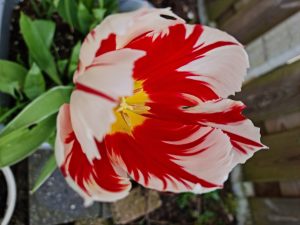With pride and joy, I shared a photo of this bloom in my last post. It was the first cultivated flower that opened its delicate, frilly, colourful wings in my garden this spring. But it is no more. As the biblical writers tell us, “The grass withers and the flower fades.”

It has, indeed, faded into oblivion. But not really. It has left its fruit behind. And that tiny fruit has seeds. The horticultural breeders know that these taken-for-granted little-bits have purpose. They make for the species’ longevity. It might take the hybridizers 12 years of cross pollination to come up with another new spectacular variety at Keukenhoff or some other iconic botanical garden. But in the in-between time, more plants will grow from the seeds.
What I want to emphasise is that the flower is itself a promise of more to come. When you see the first bloom you know that others will follow once the conditions are right. Even before the cycle of fruiting and seeding gives rise to new generations, the flowers get company as the weather elements that cause them to flourish do the same for other flowering plants. So, there I am, hoping for more.
Which raises a question. How much longer can we expect the cycles of nature to continue as they have been doing, when we abuse the environment and induce, even provoke climate change? Our consumerism and carelessness concerning creation is showing stark results. In many situations and for many species, growing conditions are threatened. Extinction is their horizon. While we may concentrate on lovely gardens, what happens in the wild is what affects most of the flora and fauna that keep creation in balance.
How we affect creation has a lot to do with things other than growing or not growing flowering and other plants. There are ways in which we can hurt or help. We can help, yes, as we Reduce, Reuse and Recycle waste. That’s all I’ll mention for today. My focus is on what I just heard on the RTL news: statiegedf voor kleine flesjes naar 50 cent. Yes, that’s Dutch. Statiegeld is the charge on recyclables. If you return your plastic bottles (for which you would have paid statiegeld) then you get that money back. Well, authorities have noted that while there is an 80% return rate of larger bottles for which you pay more statiegeld at purchase, the return rate drops significantly for smaller bottles (kleine flesjes) which cost the consumer only 15 cents. So, what do they do? Up the price. From next week, you pay not 15, but 50 cents! I hope this works. I hope that the 50-cent squeeze will have consumers think twice about throwing their plastic bottles into the wild where they do untold damage as they wind their way into the oceans, killing wildlife like guns.
Of course, this is only one bad habit that can adversely affect the “more to come” of creatin. But that’s for another post.
Tot ziens.
